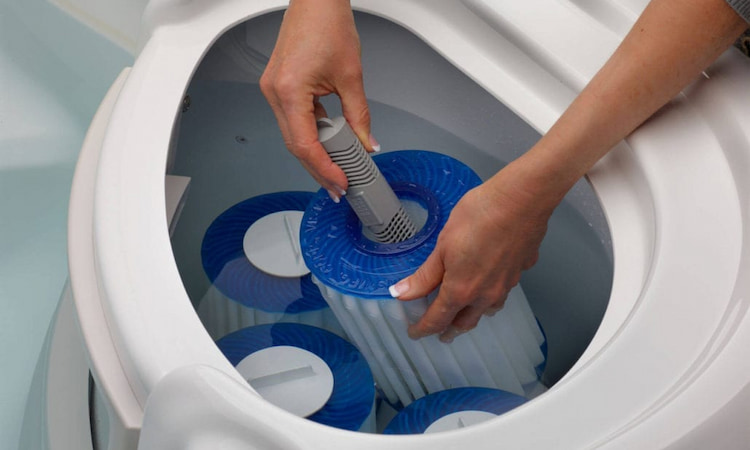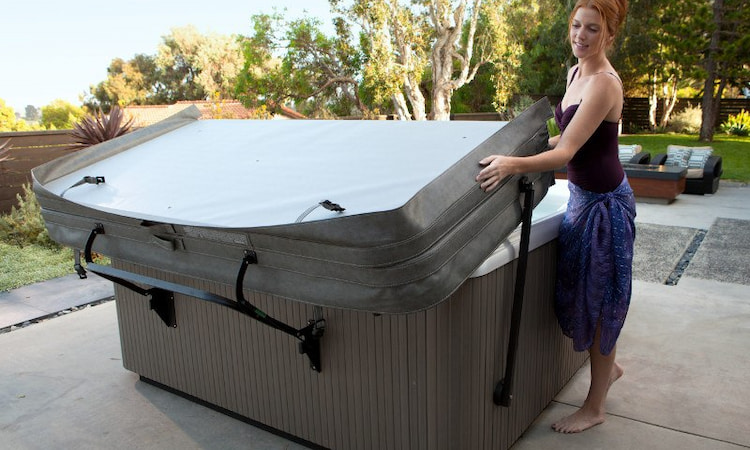You’re enjoying your hot tub, but do you know when to change its water? It’s not just about comfort, it’s crucial for your health too.
You should change hot tub water every three to four months. This depends on how often you use your hot tub and the number of users. Over time, the water can become saturated with chemicals and waste products which can affect the performance of the hot tub and your health.
Let’s dive into when and why you should change your hot tub water, and how to keep it healthier for longer.

Quick Navigation
How to Know if the Hot Tub Water Needs To Be Changed?
You’ll know it’s time to change your hot tub water when you notice three key signs: persistent foam, unpleasant odors, and cloudy or discolored water.
These are not just aesthetically displeasing but also indicate a significant imbalance in your water chemistry, which can lead to skin irritations or even damage to your hot tub’s components.
Persistent foam, for instance, is often a sign of high contaminant levels, such as oils, lotions, or detergents. A quick fix might be using a defoamer, but if the foam keeps reappearing, it’s a clear signal that your water needs changing.
Unpleasant odors, on the other hand, typically point toward bacterial growth or a high concentration of waste materials. This is not something you should ignore, as it poses a health risk to you and your family.
Lastly, if your water appears cloudy or discolored, it’s usually due to excessive minerals, organic materials, or a failing filter. Again, this is more than just an aesthetic issue; it’s a sign that your water chemistry is off.
How Frequently Should You Change Your Hot Tub Water
After spotting any of these signs, it’s generally recommended that you change your hot tub water every three to four months.
This frequency ensures that your tub stays clean, hygienic, and safe for use. However, this can vary based on usage and water quality.
| Factors Affecting Frequency | Description |
|---|---|
| Frequency of Use | More use means more contaminants, requiring more frequent changes. |
| Number of Users | More users increase the load on your tub’s filter and sanitizer. |
| Quality of Water | Hard water or water with high mineral content may need more frequent changes. |
| Maintenance | Regular maintenance can extend the time between water changes. |
| Use of Chemicals | The more chemicals you use, the more frequently you should change the water. |
What Happens if You Don’t Change Bad Water When Needed
Without regular water changes, the balance of chemicals can become hard to manage and less effective at keeping the water clean. This could lead to the growth of bacteria and algae, making your hot tub a breeding ground for pathogens.
Moreover, continuous addition of chemicals without changing the water can result in a buildup of chloramines. These byproducts of chlorine can cause skin and eye irritation, and may even lead to respiratory issues when inhaled.
Not only that, but your hot tub’s equipment can also suffer. The accumulation of minerals and chemicals can cause scaling and corrosion, which can damage your hot tub’s heater, pump, and other components over time.
Simply put, trying to keep bad hot tub water clean by only adding more chemicals is a risky practice. It’s not just about maintaining clear water, it’s also about ensuring a safe and healthy environment for you to relax in.
Related Read: How to Maintain a Hot Tub Without Chemicals?
How to Keep Hot Tub Water Healthy Longer

Despite the inevitable need for regular water changes, there are steps you can take to make your hot tub water stay healthy for a longer period.
Here are five key tips to help you out:
- Regular Testing: Test your hot tub water regularly to monitor the pH, alkalinity, and sanitizer levels. This helps you maintain the right balance and prevent issues.
- Frequent Filter Cleaning: Clean your hot tub filter regularly. A dirty filter can’t effectively trap contaminants, leading to cloudy or dirty water.
- Use a Hot Tub Cover: Using a hot tub cover when it’s not in use can prevent debris and contaminants from entering the water.
- Shower Before Use: Encourage all users to shower before entering the hot tub. This reduces the amount of oils, lotions, and other contaminants that can enter the water.
- Regular Shocking: Regularly shock your hot tub to eliminate bacteria and other contaminants. This helps extend the life of your hot tub water.
Frequently Asked Questions
You’ll notice signs of bacterial infection in hot tub water like cloudy or foamy water, a foul smell, or skin rashes after use. Slime or residue on the tub’s surfaces are also clear indicators.
The size and usage of your hot tub greatly influence water change frequency. Larger tubs and frequent use increase contaminants, requiring more frequent changes. Conversely, smaller, less-used tubs don’t need water changes as often.
If you don’t change your hot tub water regularly, you’re risking skin irritations, bacterial infections, and respiratory issues. Unchanged water can also lead to the growth of harmful bacteria like Legionella and Pseudomonas.
Yes, the initial water quality can impact your hot tub’s maintenance schedule. If it’s high in minerals or contaminants, you’ll need to change the water more frequently to maintain cleanliness and safe use.
Yes, you can safely use well water for your hot tub. However, it’s often harder and requires more frequent changes and chemicals to balance its mineral content compared to municipal water.
Conclusion
In conclusion, maintaining your hot tub’s water quality is crucial for both your health and the lifespan of the tub. It’s generally recommended to change the water every three to four months.
Neglecting this can lead to unhealthy, chemically imbalanced water. However, you can extend the life of your hot tub water through regular monitoring and maintenance.


![How Many Gallons of Water in a Hot Tub? [Different Sized Hot Tubs] how many gallons of water in a hot tub](https://hottubtales.com/wp-content/uploads/2023/10/how-many-gallons-of-water-in-a-hot-tub.jpg)
![Is Yellow Hot Tub Water Safe? [& Treatment Options] is yellow water in hot tub safe](https://hottubtales.com/wp-content/uploads/2023/10/is-yellow-water-in-hot-tub-safe-250x150.jpg)


